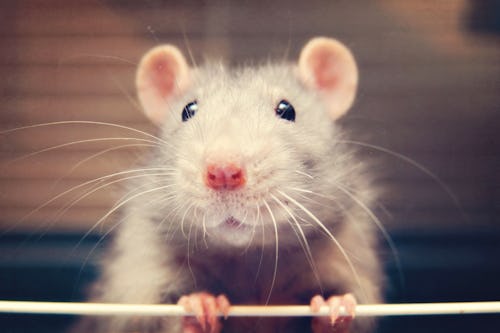
Living with little to no physical contact during the pandemic has reminded many of us of just how much we need it. As it turns out, another member of the animal kingdom — one most fondly known to occasionally haul a slice of pizza down the steps of NYC subways — might also benefit from touch. Scientists from the Center for Health and Medical Research in Canberra, Australia found that rats tickled every day for a month responded better to human handling than their un-tickled counterparts, the New York Times reported — which raises a question we bet you didn’t anticipate pondering at the start of the workweek: Could rat-tickling hold the secrets to our wellbeing?
The scientists who conducted the study wanted to know whether tickling lab rats would enhance their emotional wellbeing, which could potentially allow them to be better models for research. Indeed, many studies rely on rats to model human biology.
A poster detailing the findings explained that animal technicians tickle rats to mimic play-fighting behavior among juvenile rats. “By participating in this behavior with our rats, we aim to lessen the impact of handling and increase positive associations with human interaction,” it noted.
While the study seems to mark the first rat-tickling study conducted in Australia, per the Times, earlier research from the U.K., Germany, and other countries have already shown that rats make ultrasonic vocalizations — that is, vocalizations at frequencies beyond what humans can hear — when tickled. (Need a breather from the news cycle other than the usual cat vid or astrology meme? Might we recommend listening to rats “giggling” in response to being tickled, recorded with a specialized microphone, here.)
The researchers in Canberra tickled a group of rats every day for four weeks and documented their responses using a scoring system, according to the poster. They compared them to a group of rats that remained untickled. In general, tickled rats responded better to human handling and showed less fear. “Content, unstressed animals that live enriched lives are better able to contribute to high quality research,” the researchers concluded in the poster.
Tickling a rat isn’t as straightforward as it might seem. As with any technique, “there is a right and a wrong way to tickle a rat,” Carlee Mottley, a laboratory animal technician at the University of Wollongong and a certified rat tickler, who wasn’t involved in the study, told the Times. Done incorrectly, it can confuse and even hurt them. Makes sense, since tickling can feel torturous to humans if done the wrong way.
Correctly tickling a rat can involve gently holding it around its front legs and lifting it as you flip it onto its back, which mirrors what the rodents do when they wrestle, per the Times. You could also keep the rat on its back as you tickle its chest and between its front legs, the newspaper added, or lightly touch the back of its neck.
If these findings inspire you to bring joy and laughter to the next rat you see instead of shrieking or swearing at it, “it’s a mistake to assume all rats are into tickling, and a mistake to assume that all humans are equally good at tickling rats,” Paul McGreevy, a professor of animal behavior and welfare at the University of New England, told the Times.
Rats, like humans, benefit from touch, but only when it's done with skill and sensitivity to what they actually want. In other words, we might have more in common with Pizza Rat than we think.







